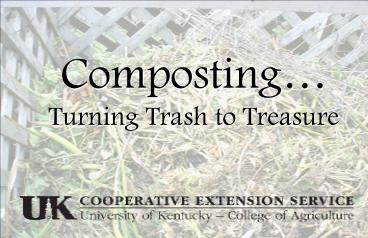Composting Turning Trash to Treasure - PowerPoint PPT Presentation
1 / 9
Title:
Composting Turning Trash to Treasure
Description:
Compost acts as soil 'glue' holding soil particles ... Compost reduces the amount of waste that enters our landfills! ... Clothes Dryer Lint. Cardboard Rolls ... – PowerPoint PPT presentation
Number of Views:88
Avg rating:3.0/5.0
Title: Composting Turning Trash to Treasure
1
CompostingTurning Trash to Treasure
2
What is compost?
Compost is decomposed organic materials.
3
Why compost?
- Compost improves our soil!
- Compost acts as soil glue holding soil
particles together. - Compost helps soil hold more water.
- Compost contains nutrients plants need.
4
Why compost?
- Compost reduces the amount of chemical
fertilizers needed, thereby saving you money! - Compost reduces the amount of waste that enters
our landfills! - Did you knowyard and kitchen waste make up 20 -
25 of the waste going to our landfills?
5
Building a Compost Bin
Compost bins can be built easily inexpensively!
Construct a compost bin out of wire-mesh,
wooden pallets, a garbage can, or make a worm
composting bin!Easy to use instruction sheets
are available at your Cooperative Extension
Office.Compost bins are also available for
purchase and vary in size and price.
Garbage can compost bin. Image obtained from ENRI
311 Constructing a Garbage Can Compost Bin.
6
Composting Recipe for Success
Ingredients AirWater Green Materials
Brown Materials
As you build your compost pile, think of a
layered cake. Alternatematerials that are
green with materials that are brown. Remember
your compost pile needs water and air just like
you do! Green materials are high in nitrogen
(examples include food scraps, grass clippings,
and manure). Brown materials are high in
carbon (examples include paper, sawdust,
woodchips, leaves, straw).
7
What goes into compost?
Fruit and Vegetable ScrapsHuman Hair, Fur,
Feathers Clothes Dryer Lint Cardboard
Rolls Newspaper or Shredded Paper (Avoid Colored
and Shiny/Glossy Kind)Straw or HayEggshells,
Coffee Grounds, TeabagsNutshellsGrass
Clippings Yard WasteLeaves - Fresh or Dry -
From Trees ShrubsSawdust or Wood shavings (in
Small Quantities)
8
What does NOT go into compost?
- No Nos
- Meat, Meat Products, Bones, or Fish
- Fats, Greases, or Oils
- Baked Goods - Breads, Cookies, Cakes, Pies
- Dairy Products - Milk, Yogurt, Cheeses
- Weeds that are hard to kill or that have gone to
seed - Kitty Litter or Pet Waste
- Yard Waste Treated with Chemicals
- Black Walnut Leaves/Twigs
- Coal or Charcoal Ashes
- Citrus
- OnionMeats, bones, fats, greases, oils, baked
goods, diary products can attract pests, create
odor problems, and mold.If you have a worm
bin, do not add anything that would irritate your
eyes, like onion or citrus, this can irritate the
worms skin.
9
For more information
Contact Ashley Osborne at ashley.osborne_at_uky.edu
or 859-257-2505 or your local Extension
office.Visit http//www.ca.uky.edu/enri/compost.
php for downloadable fact sheets, interactive
games, and more related to compost.































